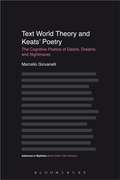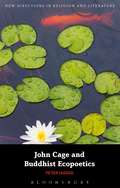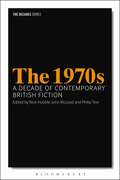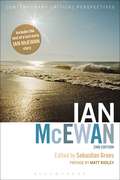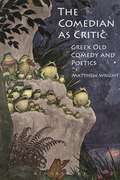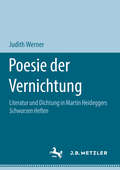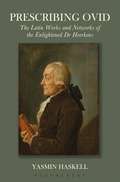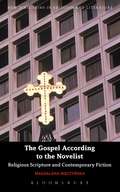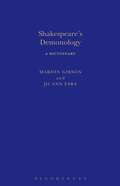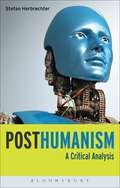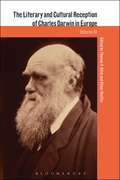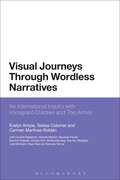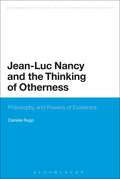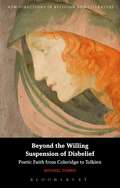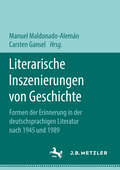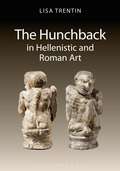- Table View
- List View
The Art of Law in Shakespeare
by Paul RaffieldThrough an examination of five plays by Shakespeare, Paul Raffield analyses the contiguous development of common law and poetic drama during the first decade of Jacobean rule. The broad premise of The Art of Law in Shakespeare is that the 'artificial reason' of law was a complex art form that shared the same rhetorical strategy as the plays of Shakespeare. Common law and Shakespearean drama of this period employed various aesthetic devices to capture the imagination and the emotional attachment of their respective audiences. Common law of the Jacobean era, as spoken in the law courts, learnt at the Inns of Court and recorded in the law reports, used imagery that would have been familiar to audiences of Shakespeare's plays. In its juridical form, English law was intrinsically dramatic, its adversarial mode of expression being founded on an agonistic model. Conversely, Shakespeare borrowed from the common law some of its most critical themes: justice, legitimacy, sovereignty, community, fairness, and (above all else) humanity. Each chapter investigates a particular aspect of the common law, seen through the lens of a specific play by Shakespeare. Topics include the unprecedented significance of rhetorical skills to the practice and learning of common law (Love's Labour's Lost); the early modern treason trial as exemplar of the theatre of law (Macbeth); the art of law as the legitimate distillation of the law of nature (The Winter's Tale); the efforts of common lawyers to create an image of nationhood from both classical and Judeo-Christian mythography (Cymbeline); and the theatrical device of the island as microcosm of the Jacobean state and the project of imperial expansion (The Tempest).
Text World Theory and Keats' Poetry: The Cognitive Poetics of Desire, Dreams and Nightmares (Advances in Stylistics)
by Marcello GiovanelliText World Theory and Keats' Poetry applies advances in cognitive poetics and text world theory to four poems by the nineteenth century poet John Keats. It takes the existing text world theory as a starting point and draws on stylistics, literary theory, cognitive linguistics, cognitive psychology and dream theories to explore reading poems in the light of their emphasis on states of desire, dreaming and nightmares. It accounts for the representation of these states and the ways in which they are likely to be processed, monitored and understood. Text World Theory and Keats' Poetry advances both the current field of cognitive stylistics but also analyses Keats in a way that offers new insights into his poetry. It is of interest to stylisticians and those in literary studies.
The Reception of Charles Dickens in Europe (The Reception of British and Irish Authors in Europe)
by Michael HollingtonThe Reception of Charles Dickens in Europe offers a full historical survey of Dickens's reception in all the major European countries and many of the smaller ones, filling a major gap in Dickens scholarship, which has by and large neglected Dickens's fortunes in Europe, and his impact on major European authors and movements. Essays by leading international critics and translators give full attention to cultural changes and fashions, such as the decline of Dickens's fortunes at the end of the nineteenth century in the period of Naturalism and Aestheticism, and the subsequent upswing in the period of Modernism, in part as a consequence of the rise of film in the era of Chaplin and Eisenstein. It will also offer accounts of Dickens's reception in periods of political upheaval and revolution such as during the communist era in Eastern Europe or under fascism in Germany and Italy in particular.
John Cage and Buddhist Ecopoetics (New Directions in Religion and Literature)
by Peter JaegerJohn Cage was among the first wave of post-war American artists and intellectuals to be influenced by Zen Buddhism and it was an influence that led him to become profoundly engaged with our current ecological crisis. In John Cage and Buddhist Ecopoetics, Peter Jaeger asks: what did Buddhism mean to Cage? And how did his understanding of Buddhist philosophy impact on his representation of nature? Following Cage's own creative innovations in the poem-essay form and his use of the ancient Chinese text, the I Ching to shape his music and writing, this book outlines a new critical language that reconfigures writing and silence. Interrogating Cage's 'green-Zen' in the light of contemporary psychoanalysis and cultural critique as well as his own later turn towards anarchist politics, John Cage and Buddhist Ecopoetics provides readers with a critically performative site for the Zen-inspired “nothing” which resides at the heart of Cage's poetics, and which so clearly intersects with his ecological writing.
Michel Houellebecq and the Literature of Despair
by Carole SweeneyWidely acknowledged as an important, if highly controversial, figure in contemporary literature, French novelist and poet Michel Houellebecq has elicited diverse critical responses.In this book Carole Sweeney examines his novels as a response to the advance of neoliberalism into all areas of affective human life. This historicizing study argues that le monde houellebecquien is an 'atomised society' of banal quotidian alienation populated by quietly resentful men who are the botched subjects of late-capitalism. Addressing Houellebecq's handling of the 'failure' of the radical thought of '68, Sweeney looks at the ways in which his fiction treats feminism, the decline of religion and the family, as well asthe obsolescence of French 'theory' and the Sartrean notion of 'engaged' literature. Reading the world with the disappointed idealism of a contemporary moralist, Houellebecq's novels, Sweeney argues, fluctuate between despair for the world as it is and a limp utopian hope for a post-humanity.
1970s, The: A Decade Of Contemporary British Fiction (The Decades Series)
by Nick Hubble John McLeod Philip TewHow did social, cultural and political events in Britain during the 1970s shape Contemporary British Fiction? Exploring the impact of events like the Cold War, miners' strikes and Winter of Discontent, this volume charts the transition of British fiction from post-war to contemporary. Chapters outline the decade's diversity of writing, showing how the literature of Ian McEwan and Ian Sinclair interacted with the experimental work of B.S. Johnson. Close contextual readings of Welsh, Scottish, Northern Irish and English novels map the steady break-up of Britain. Tying the popularity of Angela Carter and Fay Weldon to the growth of the Women's Liberation Movement and calling attention to a new interest in documentary modes of autobiographical writing, this volume also examines the rising resonance of the marginal voices: the world of 1970s British Feminist fiction and postcolonial and diasporic writers. Against a backdrop of social tensions, this major critical reassessment of the 1970s defines, explores and better understands the criticism and fiction of a decade marked by the sense of endings.
Ian McEwan: Contemporary Critical Perspectives, 2nd edition (Contemporary Critical Perspectives)
by Sebastian GroesIan McEwan is one of the most significant, and controversial, British novelists working today. His books are both critically - and academically - acclaimed and embraced by readers across the world. Although primarily a novelist, he has also written short stories, television plays, a libretto, a children's book and a film adaptation. Across these many forms his work retains a distinctive character that explores questions of morality, place and history, nationhood, sexuality and gender.Now fully updated for its second edition, this guide brings together a collection of new critical perspectives on McEwan's oeuvre, not only covering the early works and his writing for the screen but also incorporating detailed and original analyses of the later work, including new readings of his latest books, Solar and Sweet Tooth. With an updated and extended guide to further critical reading on McEwan, the book also includes an interview with the author himself, a chronology of his life, work and times and the full text of a lost early McEwan short story.
English in Practice: In Pursuit of English Studies
by Peter BarryFully revised and updated, this new edition of English in Practice continues to be an essential practical guide to studying English at University. It is for all those who are about to embark on an English degree or are in the midst of completing one, and for those who want to re-engage with their reasons for teaching it. The second edition now includes new chapters offering practical advice on writing undergraduate dissertations and on taking your studies beyond undergraduate level, as well as a thoroughly updated chapter on getting the most of out of online resources. Written by an experienced writer and teacher, the book also covers such topics as: • Reading and interpretation • English and Creative Writing • Literary criticism and theory • The English language • Exploring historical contexts • Constructing an essayIncluding an annotated guide to further reading, English in Practice is an important resource for students keen to succeed in their study of English at University.
The Comedian as Critic: Greek Old Comedy and Poetics
by Matthew WrightSome of the best evidence for the early development of literary criticism before Plato and Aristotle comes from Athenian Old Comedy. Playwrights such as Eupolis, Cratinus, Aristophanes and others wrote numerous comedies on literary themes, commented on their own poetry and that of their rivals, and played around with ideas and theories from the contemporary intellectual scene. How can we make use of the evidence of comedy? Why were the comic poets so preoccupied with questions of poetics? What criteria emerge from comedy for the evaluation of literature? What do the ancient comedians' jokes say about their own literary tastes and those of their audience? How do different types of readers in antiquity evaluate texts, and what are the similarities and differences between 'popular' and 'professional' literary criticism? Does Greek comedy have anything serious to say about the authors and texts it criticizes? How can the comedians be related to the later literary-critical tradition represented by Plato, Aristotle and subsequent writers? This book attempts to answer these questions by examining comedy in its social and intellectual context, and by using approaches from modern literary theory to cast light on the ancient material.
Poesie der Vernichtung: Literatur und Dichtung in Martin Heideggers Schwarzen Heften
by Judith WernerJudith Werner untersucht, wie sich Antisemitismus in einem Kernbereich von Heideggers Denken manifestiert: seinem Dichtungs- und Literaturverständnis. Ihre Analyse der 2014/15 erschienenen Schwarzen Hefte, die ein regelrechtes Erdbeben in der Heidegger-Forschung und in den Feuilletons der deutschen und internationalen Presselandschaft auslösten, kontextualisiert die Ursprünge und Ausprägungen antisemitischer Ideologie in Heideggers Denken literatur- und philosophiegeschichtlich. Die kritische Studie nimmt die Forschungsgemeinde in die Pflicht, sich einer ehrlichen Debatte zu stellen, die Heideggers Antisemitismus weder leugnet noch philosophisch verklärt.
Trauma – Literatur – Moderne: Poetische Diskurse zum Komplex des Psychotraumas seit der Spätaufklärung
by Helmut GruggerIn diesem Buch beschreibt Helmut Grugger, wie poetische Texte hochgradig reflektierte Auseinandersetzungen mit dem Komplex des Psychotraumas erzeugen, und zeigt so, dass gerade Literatur hoher Qualität für die unterschiedlichen Diskurse zum Thema Trauma von höchstem Interesse ist. Das wichtige transdisziplinäre Thema wird anhand exemplarischer Einzelanalysen behandelt – zum ersten Mal in einer größeren, die verschiedenen Ansätze überblickenden und literarhistorisch fundierten Arbeit. Während Theoretiker die Eröffnungskapitel und Praktiker die Ergebnisse des Schlussteils besonders aufschlussreich finden, können alle literarisch Interessierten an jedem Knotenpunkt der zweihundertjährigen Textgeschichte einsteigen.
Vor dem Lustmord: Sexualisierte Gewalt in Literatur und Forensik um 1800
by Jill BühlerDie Studie von Jill Bühler untersucht ausgehend von Richard von Krafft-Ebings Psychopathia sexualis (1886) die literarische und wissenshistorische Vorgeschichte des Lustmords. Sie stellt fest, dass sich Krafft-Ebings Theorie maßgeblich aus literarischen und kriminalistischen Anschauungsbeispielen aus dem frühen 19. Jahrhundert speist. Naturphilosophie und Kriminalpsychologie ermitteln bereits um 1800 Erscheinungen sexualisierter Gewalt – und die zeitgenössische Literatur offenbart ihre Affinität dazu.
Prescribing Ovid: The Latin Works and Networks of the Enlightened Dr Heerkens
by Yasmin HaskellGerard Nicolaas Heerkens was a cosmopolitan Dutch physician and Latin poet of the eighteenth century. A Catholic, he was in many ways an outsider on his own turf, the peat country of Protestant Groningen, and looked to Voltaire's Paris, much as Ovid, in exile, had looked to Rome. An indefatigable traveller and networker, Heerkens mixed freely with philosophers, physicians, churchmen and antiquarians. This book reconstructs his Latin works and networks, and reveals in the process a virtually unexplored corner of eighteenth-century culture, the 'Latin Enlightenment'.
Euripides: Alcestis (Companions to Greek and Roman Tragedy)
by Niall W. SlaterIn the Alcestis, the title character sacrifices her own life to save that of her husband, Admetus, when he is presented with the opportunity to have someone die in his place. Alcestis compresses within itself both tragedy and its apparent reversal, staging in the process fascinating questions about gender roles, family loyalties, the nature of heroism, and the role of commemoration.Alcestis is Euripides's earliest complete work and his only surviving play from the period preceding the outbreak of the Peloponnesian War. Currently dominant post-structuralist models of Greek tragedy focus on its 'oppositional' role in the discourse of war and public values. This study challenges not only this politicised model of tragic discourse but also both traditional masculinist and more recent feminist readings of the discourse and performance of gender in this remarkable play. The play survived in the performance repertoire of antiquity into the Roman period. Euripides' version strongly influenced the reception of the myth through the middles ages into the Renaissance, and the story enjoyed a lively afterlife through opera. Alcestis' contested reception in the last two centuries charts our changing understanding of tragedy.Niall Slater's study explores the reception and afterlife of the play, as well as its main themes, the myth before the play, the play's historical and social context and the central developments in modern criticism.
The Gospel According to the Novelist: Religious Scripture and Contemporary Fiction (New Directions in Religion and Literature)
by Magdalena MaczynskaWhy have so many prominent literary authors-from Philip Pullman and José Saramago to Michèle Roberts and Colm Tóibím-recently rewritten the canonical story of Jesus Christ? What does that say about our supposedly secular age? In this insightful study, Magdalena Maczynska defines and examines the genre of scriptural metafiction: novels that not only transform religious texts but also draw attention to these transformations. In addition to providing rich examples and close readings, Maczynska positions literary studies within interdisciplinary debates about religion and secularity. Her book demonstrates a surprising turn of events: even as contemporary novelists deconstruct the traditional categories of "secular†? and "sacred†? writing, they open up new spaces for scripture in contemporary culture.
Shakespeare's Demonology: A Dictionary (Arden Shakespeare Dictionaries)
by Marion Gibson Jo Ann EsraIs postdramatic theatre political and if so how? How does it relate to Brecht's ideas of political theatre, for example? How can we account for the relationship between aesthetics and politics in new forms of theatre, playwriting, and performance?The chapters in this book discuss crucial aspects of the issues raised by the postdramatic turn in theatre in the late twentieth and early twenty-first century: the status of the audience and modes of spectatorship in postdramatic theatre; the political claims of postdramatic theatre; postdramatic theatre's ongoing relationship with the dramatic tradition; its dialectical qualities, or its eschewing of the dialectic; questions of representation and the real in theatre; the role of bodies, perception, appearance and theatricality in postdramatic theatre; as well as subjectivity and agency in postdramatic theatre, dance and performance.Offering analyses of a wide range of international performance examples, scholars in this volume engage with Hans-Thies Lehmann's theoretical positions both affirmatively and critically, relating them to other approaches by thinkers ranging from early theorists such as Brecht, Adorno and Benjamin, to contemporary thinkers such as Fischer-Lichte, Rancière and others
G.K. Chesterton, London and Modernity (Bloomsbury Studies in the City)
by Matthew Beaumont Matthew InglebyG. K. Chesterton, London and Modernity is the first book to explore the persistent theme of the city in Chesterton's writing. Situating him in relation to both Victorian and Modernist literary paradigms, the book explores a range of theoretical and methodological approaches to address the way his imaginative investments and political interventions conceive urban modernity and the central figure of London. While Chesterton's work has often been valued for its wit and whimsy, this book argues that he is also a distinctive urban commentator, whose sophistication has been underappreciated in comparison to more canonical contemporaries. With chapters written by leading scholars in the field of 20th-century literature, the book also provides fresh readings and suggests new contexts for central texts such as The Man Who Was Thursday, The Napoleon of Notting Hill and the Father Brown stories. It also discusses lesser-known works, such as Manalive and The Club of Queer Trades, drawing out their significance for scholars interested in urban representation and practice in the first three decades of the 20th century.
Posthumanism: A Critical Analysis
by Stefan HerbrechterWhat does it mean to be human today? The answer to this question, which is as old as the human species itself, is becoming less and less certain. Current technological developments increasingly erode our traditional humanist reflexes: consciousness, emotion, language, intelligence, morality, humour, mortality - all these no longer demonstrate the unique character and value of human existence. Instead, the spectre of the 'posthuman' is now being widely invoked as the 'inevitable' next evolutionary stage that humans are facing.Who comes after the human? This is the question that posthumanists are taking as their starting point. This critical introduction understands posthumanism as a discourse, which, in principle, includes everything that has been and is being said about the figure of the 'posthuman'. It outlines the genealogy of the various posthuman 'scenarios' in circulation and engages with their theoretical and philosophical assumptions and social and political implications. It does so by connecting the philosophical debate about the future of humanity with a range of texts, including examples from new media, popular culture, science and the media.
Remembering the Holocaust: Generations, Witnessing and Place
by Esther JilovskyAn intriguing analysis of how place constructs memory and how memory constructs place, Remembering the Holocaust shows how visiting sites such as Auschwitz shapes the transfer of Holocaust memory from one generation to the next. Through the discussion of a range of memoirs and novels, including Landscapes of Memory by Ruth Kluger, Too Many Men by Lily Brett, The War After by Anne Karpf and Everything is Illuminated by Jonathan Safran Foer, Remembering the Holocaust reveals the pivotal yet complicated role of place in each generation's writing about the Holocaust.This book provides an insightful and nuanced investigation of the effect of the Holocaust upon families, from survivors of the genocide to members of the second and even third generations of families involved. By deploying an innovative combination of generational and literary study of Holocaust survivor families focussed on place, Remembering the Holocaust makes an important contribution to the field of Holocaust Studies that will be of interest to scholars and anyone interested in Holocaust remembrance.
The Literary and Cultural Reception of Charles Darwin in Europe (The Reception of British and Irish Authors in Europe)
by Thomas F. Glick Elinor ShafferBeyond his pivotal place in the history of scientific thought, Charles Darwin's writings and his theory of evolution by natural selection have also had a profound impact on art and culture and continue to do so to this day. The Literary and Cultural Reception of Charles Darwin in Europe is a comprehensive survey of this enduring cultural impact throughout the continent. With chapters written by leading international scholars that explore how literary writers and popular culture responded to Darwin's thought, the book also includes an extensive timeline of his cultural reception in Europe and bibliographies of major translations in each country.
Visual Journeys Through Wordless Narratives: An International Inquiry With Immigrant Children and The Arrival
by Evelyn Arizpe Teresa Colomer Carmen Martínez-RoldánWinner of the Literacy Research Association's 2015 Edward B. Fry Book AwardImmigration is an ongoing, global phenomenon and schools and teachers in host countries must continually find new ways of working with the increasing numbers of immigrant pupils, including refugees and asylum seekers. Language and literacy are crucial for inclusion in a new context but these must be developed in spaces where these children feel safe to explore themes that resonate with their experiences; to express their understanding and to engage in intercultural exchange. Visual Journeys Through Wordless Narratives presents the exploration of response strategies to Shaun Tan's The Arrival. The inquiry was carried out in educational settings, with children from many different parts of the world, in four host countries: the UK, Spain, Italy and the USA. The findings reveal the benefits of using wordless narratives such as picturebooks and graphic novels together with visual strategies to support immigrant children's literary understandings and visual literacy. They also reveal the wealth of experiences the children bring with them which have the potential to transform educational practices.
Jean-Luc Nancy and the Thinking of Otherness: Philosophy and Powers of Existence (Bloomsbury Studies in Continental Philosophy)
by Daniele RugoJean-Luc Nancy and the Thinking of Otherness is the first book in English to provide a sustained account of the relationship between Nancy, Levinas and Heidegger. It investigates Jean-Luc Nancy's reading of Heidegger, focusing on the question of Being-with, and starting with the problem of otherness in Heidegger, the book goes on to establish a dialogue between Nancy and the philosophy of Emmanuel Levinas.With intellectual agility and command of cinema, literature and visual art, Daniele Rugo insists on the critical significance of Nancy's project for any future philosophy attempting to define itself beyond foundational acts, and according to the continuous crossings at the heart of existence. By discussing Nancy alongside Heidegger and Levinas, Rugo underlines the essential indecision between philosophy-as-literature and philosophy as the re-appropriation of the question of Being. Rugo offers unexpected associations which return thinking to the play of specificity, rather than restricting it to the passage of abstract formulations.
Beyond the Willing Suspension of Disbelief: Poetic Faith from Coleridge to Tolkien (New Directions in Religion and Literature)
by Michael TomkoSamuel Taylor Coleridge's conception of "the willing suspension of disbelief" marks a pivotal moment in the history of literary theory. Returning to Coleridge's thought and Shakespeare criticism to reconstruct this idea as a form of "poetic faith", Michael Tomko here lays the foundations of a new theologically oriented mode of literary criticism. Bringing Coleridge into dialogue with thinkers ranging from Augustine to Josef Pieper, contemporary critics such as Stephen Greenblatt and Terry Eagleton as well as writers like J.R.R. Tolkien and Wendell Berry, Beyond the Willing Suspension of Disbelief offers a method of reading for post-secular literary criticism that is not only historically and politically aware but also deeply engaged with aesthetic form.
Literarische Inszenierungen von Geschichte: Formen der Erinnerung in der deutschsprachigen Literatur nach 1945 und 1989
by Manuel Maldonado-Alemán Carsten GanselDie Beitragsautoren dieses Sammelbandes gehen der Frage nach, welche Rolle das Erinnern in der deutschsprachigen Literatur nach 1945 und sodann nach dem Umbruch des Jahres 1989 spielt. Dabei werden unterschiedlich Formen der literarischen Konfiguration von Erinnerung untersucht und das Verhältnis von Fakt und Fiktion diskutiert. In den Blick geraten unterschiedliche Poetologien, Schreibweisen und Konzepte beim Umgang mit Geschichte.
The Hunchback in Hellenistic and Roman Art
by Lisa TrentinThe subject of deformity and disability in the ancient Greco-Roman world has experienced a surge in scholarship over the past two decades. Recognizing a vast, but relatively un(der)explored, corpus of evidence, scholars have sought to integrate the deformed and disabled body back into our understanding of ancient society and culture, art and representation. The Hunchback in Hellenistic and Roman Art works towards this end, using the figure of the hunchback to re-think and re-read images of the 'Other' as well as key issues that lie at the very heart of ancient representation. The author takes an art-historical approach, examining key features of the corpus of hunchbacks, as well as representations of the deformed and disabled more generally. This provides fertile ground for a re-assessment of current, and likewise marginalized, scholarship on the miniature in ancient art, hyperphallicism in ancient art, and the emphasis on the male body in ancient art.

